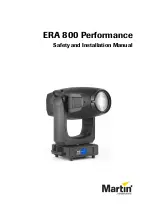
1-1
IM 701450-51E
I
2
C Bus Signal Analysis Function
1
Chapter 1
I
2
C Bus Signal Analysis Function
1.1
Overview of the I
2
C Bus Signal Analysis
Function
About the I
2
C Bus Signal Analysis Function
I
2
C Bus is an abbreviation for Integrated Circuit Bus. It is a bidirectional bus for
connecting ICs. By using this function, you will be able to analyze data while displaying
the I
2
C-bus signal waveform. The I
2
C Bus Signal Analysis Function consists of the
following three main functions.
Trigger Function <See page 1-4 for the operating procedure>
Various trigger conditions for the I
2
C Bus signal can be set up such as when a start
condition is detected, when an Acknowledge bit is not detected, when the specified
address (7 bits + R/W
_
) pattern is met, or when the data pattern is met or not met (Non-
Ack trigger or address & data trigger).
Triggers can also be activated by combining the I
2
C Bus signal (SCL signal (CH1)/SDA
signal (CH2) and the CH3 to CH8 signal (CH3 and CH4 on the DL7440) (combination
trigger).
...
...
SDA
SCL
Start condition
1 2 3 4 5 6 7 8 9
Acknowledge bit
Data byte
Trigger activated here
1 2 3 4 5 6 7 8 9
Acknowledge present (L)
Acknowledge not
present (H)
Stop condition
A R/W bit
...
...
SDA
SCL
Start condition
1 2 3 4 5 6 7 8 9
Acknowledge bit
Data byte
Trigger activated here
1 2 3 4 5 6 7 8 9
Stop condition
Non-ACK Trigger Example
• When Activating a Trigger When the Acknowledge Bit Is Not Present (When the SDA Signal is high)
Address & Data Trigger Example
• When Activating a Trigger on the Start Condition or Address Pattern/Data Pattern
A R/W bit
Analysis Function <See page 1-25 for the operating procedure>
Analyzes the I
2
C Bus signal that was acquired using the trigger function and lists the
analysis data (hexadecimal notation) at the byte level and the status of the Acknowledge
bit. When you select any analysis data on this analysis result list, the I
2
C Bus signal
waveform corresponding to the analysis data is automatically displayed. You can view
the details of the analysis result such as the position of the start condition/stop condition
or the time from the analysis reference point on the detailed analysis list. You can save
the detailed analysis list on a storage medium in ASCII format.
In addition, you can analyze the data by switching between two sets of I
2
C Bus signals
(CH1: SCL and CH2: SDA or CH3: SCL and CH4: SDA).
Search Function <See page 1-28 for the operating procedure>
After analyzing the I
2
C Bus signal that was acquired using the trigger function, this
function searches in the forward or reverse direction for data that matches a specified
address pattern, data pattern, or Acknowledge bit condition, and displays the matched
data expanded on the ZOOM display. You can specify the address pattern or data
pattern using binary or hexadecimal values. You can also search indefinite data.







































